No products in the cart.
Unbraced short bending
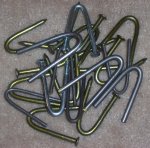
Unbraced short bending is the most popular form of bending for grip strength. It consists of bending a short metal bar into a U shape with the hands, without bracing the bar on any other part of the body. This allows for a range of bending styles, including double overhand, double underhand, reverse, and palms down style. All bending styles can be broken into three distinct phases – the initial kink, the sweep, and the crushdown.
Bars five to seven inches in length are typically bent. Bar diameters range from 3/16” to 3/8”. In most cases, some sort of padding is wrapped around the bar prior to performing the bend. This padding serves to protect the hands and may be used to gain additional leverage on the bar.
Unbraced short bending relies heavily upon strong hands and wrists. The wrists are used to transfer strength from the upper body into the hands for the bend. The hands serve to transfer the strength from the wrists into the bar and act as a fulcrum in the center of the bend. Regardless of style, crushing the bar as hard as possible while bending is critical to successfully kinking big steel.
Bending Wraps
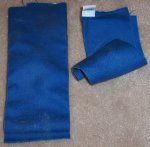
Most short steel bending is done using a pair of flexible wraps that are rolled tightly around the bar. A range of materials and wrapping styles are used, depending on the goals of the individual. Each wrap is folded down to a 12” x 4” rectangle, then rolled around the bar as tightly as possible. The tighter the wrap is, the greater the amount of force is that can be applied from the hands to the bar.
Diameter of the wrapped bar ranges from half an inch to one and a half inches. The thicker the wrapping, the easier it will be to kink the bar. The thinner the wrapping, the easier it will be to crush the bar down. Characteristics of the wrapping material will impact the effort involved in a bend. The most common wraps are as follows:
- Shop Cloth: The traditional feat of bending a 60 penny nail was done using a simple shop cloth or rag. Readily available and cheap, shop cloths will serve to pad the hand from the nail. Durability is quite low, and the risk of a nail or piece of metal puncturing the wrap is high.
- Cordura: One step up from a shop cloth, cordura is the material used by Ironmind in their bending wraps. The material is puncture resistant and durable. It provides limited leverage advantages, but will protect the hands quite well. As the cordura is much tougher than a cloth, the pad will be stiff at first, making it difficult to wrap tightly around the steel. Cordura bending wraps will season over time. The process can be accelerated by covering the pads in chalk and crumpling them repeatedly.
- Leather: The toughest accepted bending material is leather. 12” by 4” lengths of thin leather are typically used. Good leather for bending will be durable, puncture resistant, and flexible. Wrapped tightly around a nail, leather can also serve to increase leverage gained on the bend.
How to wrap

Properly wrapping a piece of stock prior to the bend is crucial to gaining maximum leverage. A good wrap will involve:
- Using plenty of chalk between the stock and the wrapping material. This assists in getting the wrap as tight as possible.
- Leaving a slight gap between the two bending wraps on the stock. This eliminates the need to fight the wrap while bending the nail.
- Securing the wrap as tightly as possible around the stock, preventing slipping during the bend. Some will even wrap one side of the nail at a time, using rubber bands to hold the wrap in place.
Bare Handed Bending

Bare handed short bending is often considered by individuals new to short bending as a potentially superior route to strength. It is not and will result in injury. Ends of a metal bar can easily puncture the flesh of the hand. Pressure from the narrow bar will kill the nerves in the hands. Scar tissue will build up over time, resulting in loss of function for fine motor tasks. Do not bend without using wraps.
Bending Stock
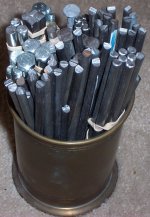
Material for bending can be acquired from a variety of sources. Benders will either order from an online retailer, or acquire stock from the local hardware store or metal supplier.
When selecting stock from on online retailer, consider price, range of available stock options, and finish on the end of the bars. Some retailers will grind down the each end of their steel, reducing risk of a bending pad puncture. The best prices can be had by purchasing the stock in volume packages, such as the Ironmind Bag of Nails or the Fat Bastard Barbell Bender’s Bags.
When purchasing stock locally, the decision needs to be made to buy metal and cut it down, or to bend available short steel such as bolts or nails. Stock purchased from a hardware store will not be much cheaper than an online retailer. Metal suppliers will provide much better prices, but usually offer steel in twenty foot lengths, requiring the purchaser to cut it. 24” bolt cutters work quite well for this purpose. Sharp bar ends can be smoothed out with a bastard mill file.
An acceptable range of stock strengths can be acquired by purchasing existing hardware. Most commonly, the following hardware is used, listed in order of increasing difficulty:
- Shiny 8 Twist Timber Ties
- Shiny 60 Penny Nails
- Dull 8 Twist Timber Ties
- Dull 12 Twist Timber Ties
- 1/4″ Grade 2 Bolts
- Dull 60 Penny Nails
- 1/4” Grade 5 Bolts
- 1/4” Grade 8 Bolts
Major hardware retailers will have timber ties and graded bolts. In order to find 60 penny nails, it may be necessary to locate a building supply store or tractor supply store. Nails are quite cheap, and can typically be found for under $2 a pound. Graded bolts are more expensive, especially from a local hardware store.
As with grippers, bending stock varies. Difficulty ranges are approximate and will differ even between nails or bolts from the same box. If one type of stock is just a little too hard, try stock from a different location. Be aware that hardware made from certain types of metal will break before it bends. When trying a new stock, take caution to be sure if it breaks, you will not be injured. High grade bolts and pole barn nails are the two types of stock that most often surprise people by breaking.
Bending Stock Progression
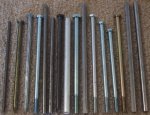
While the only way to be certain how different pieces of stock will compare is to bend them, some general guidelines can be established for estimating difficulty of a piece of short bending stock. Consider the following:
- Bar Length: All else being equal, a shorter bar is a harder bar. As the length of the bar goes down, the distance with which to gain leverage on the bend is reduced. The exception to this is that due to form problems with longer stock, some individuals find a 6” bar easier to bend than a 7” bar.
- Bar Diameter: The thicker a bar is, the harder it is. Even a 1/16” increase in bar diameter results in a dramatic increase in bar strength. A 3/8” diameter bar will require four times as much force to bend as a 3/16” diameter bar of the same material and length.
- Bar Shape: The more sides a bar has for a given diameter, the easier it will be to bend. Square stock is harder then round stock. Steel suppliers offer hexagonal stock, which will be between square and round stock.
- Bar Material: Short bending stock can be found in a variety of metals. Most typical is hot rolled or cold rolled steel. Other materials used are stainless steel, brass, and aluminum. Cold rolled steel tends to be shinier than hot rolled steel, and will also be harder to bend. Stainless steel will be harder than either of those. Aluminum and brass will be softer. The harder a material is, the sharper the bend will be. Very soft metals like Aluminum will form a wide U shape when bent. Hard metals like stainless steel will form a V shape when bent.
Bolt Cutters
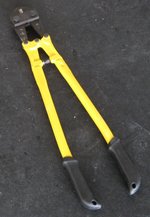
Serious benders view bolt cutters as an essential tool. The ability to cut steel to length is a requirement for incremental progression of bending stock. A quality pair of 24″ bolt cutters will easily go through steel up to 3/8″ in diameter. Take care when cutting hard metal as short pieces will leave the bolt cutters at a high speed. Smooth the sharp edge left on cut stock with a bastard mill file.
Double Overhand Style

Double overhand provides the most effective way to transfer force from the upper body through the hands into an unbraced bend, and results in destruction of the biggest steel. Because the maximal leverage is supported by reliance upon tough padding and pain tolerance, in addition to hand strength, some have dubbed this style of bending as “folding” the nail.
Force from the chest and upper back is applied through the thumb pads to bend the nail, using the index fingers as a fulcrum. Done effectively, force will also be generated by the wrists, in the form of radial deviation. The double overhand bend can be broken down as follows:
Initial Kink – The bar is grasped with an overhand grip, held as high under the chin is possible. The ends of the wrapped bar are braced in the thumb pads, with the first 2-3 fingers of the hand wrapped around the bar. Apply force down and out through the end of the bar, towards a spot two feet in front of the stomach. The thumb pads will push directly into the ends of the nail, relying upon durable pads to prevent puncture injury.
At the same time, the index fingers must push the opposite direction into the underside of the nail, driven by force from the wrists. Once the bar bends to more than 45 degrees, it’s time to move on to the sweep. For longer nails, the kink will be the hardest part of the bend.
Sweep – Transitioning from the initial kink into the sweep using double overhand requires little modification in form. Continue applying pressure through the thumb pads into the end of the nail while pushing index fingers up with the wrists. It may be possible to complete the kink and sweep in a single motion. The distinction between the two phases of the bend is important because most other bending styles will transition to double overhand for the sweep and crush down.
If multiple attempts are needed during the sweep, focus on doing them in rapid succession, applying as much force into the bar as possible. Explode into the steel. Waiting between attempts on the bar will allow the stock to cool, making the bend harder. Once the fingers meet and the bar is under 90 degrees, it is time to move into the crush down.
Crush Down – The final phase of the bend, the crush down involves bending the bar from 90 degrees down until the ends of the bar are less than two inches apart. This will be accomplished by pressing the ends of the bar together until the fingers can interlock. Once the fingers can interlock, strength from the clasped hands will be used to assist the upper body in finishing the bend. Should the wraps interfere, it may be necessary to partially unwrap the nail in order to complete the bend.
As with the sweep, it is important to transition into the crush down as quickly as possible, preventing the nail from having time to cool and harden. Should a piece of steel prove especially difficult to finish off, try grasping it in the dominant hand like a gripper, clasping the opposite hand over it, and squeezing as hard as possible.
Double Underhand Style

Relying largely upon wrist strength (radial deviation) to transfer force from the upper body through the bar, double underhand bending is performed by grasping the bar at chest level with an underhand grip. The pinkies are then driven down through the center of the bar, bending the ends up. Most of the strength for the bend comes from the triceps and upper back. Crush the bar as hard as possible with the hands to effectively transfer force into the ends of the bending stock.
Palms down style

This form of bending relies upon wrist supination and thumb strength to bend a bar, with very limited involvement of the rest of the body. The bar is grasped with the palms facing down, forearms parallel to the ground. The elbow may be straight or bent. The ends of the bar are then rotated down, towards each other, with the thumbs acting a fulcrum for the bend.
Reverse Style
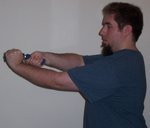
Reverse style bends rely primarily upon wrist strength in the form of radial and ulnar deviation to perform a bend. The muscle between the thumb and index finger acts as the fulcrum for the bend.
